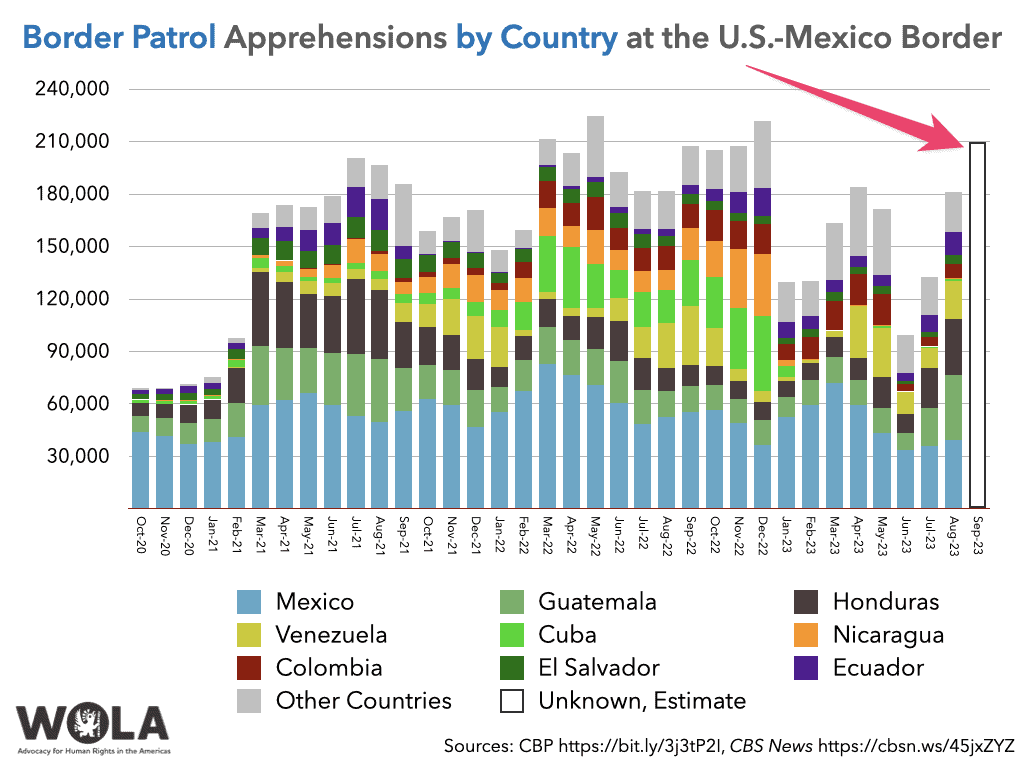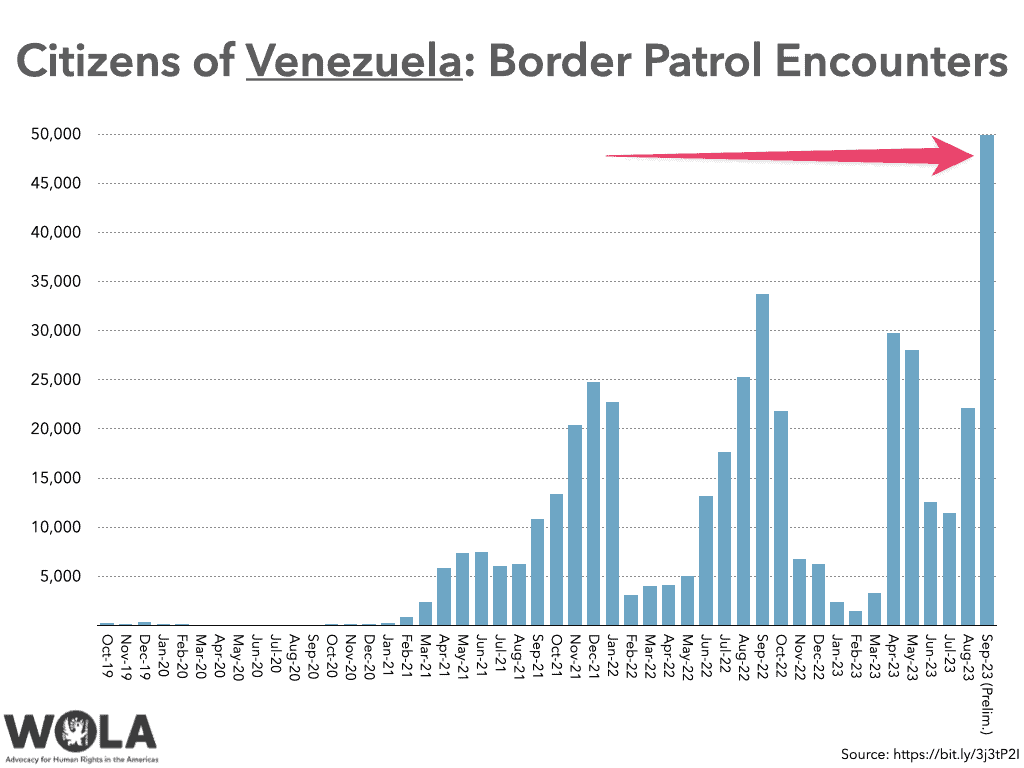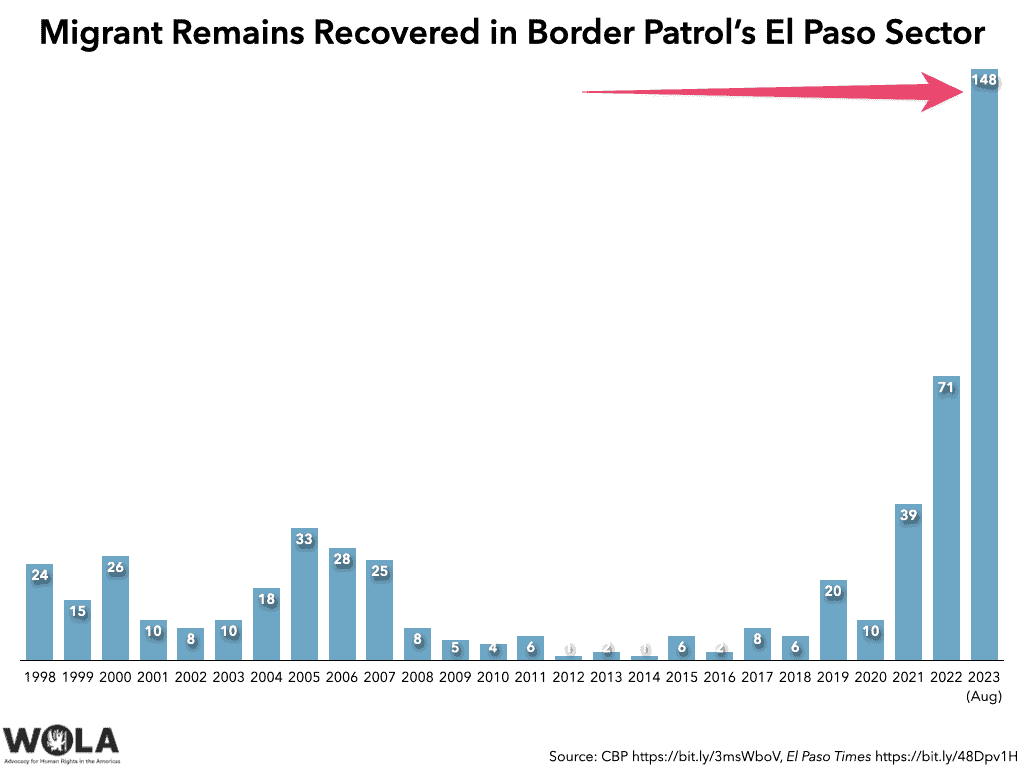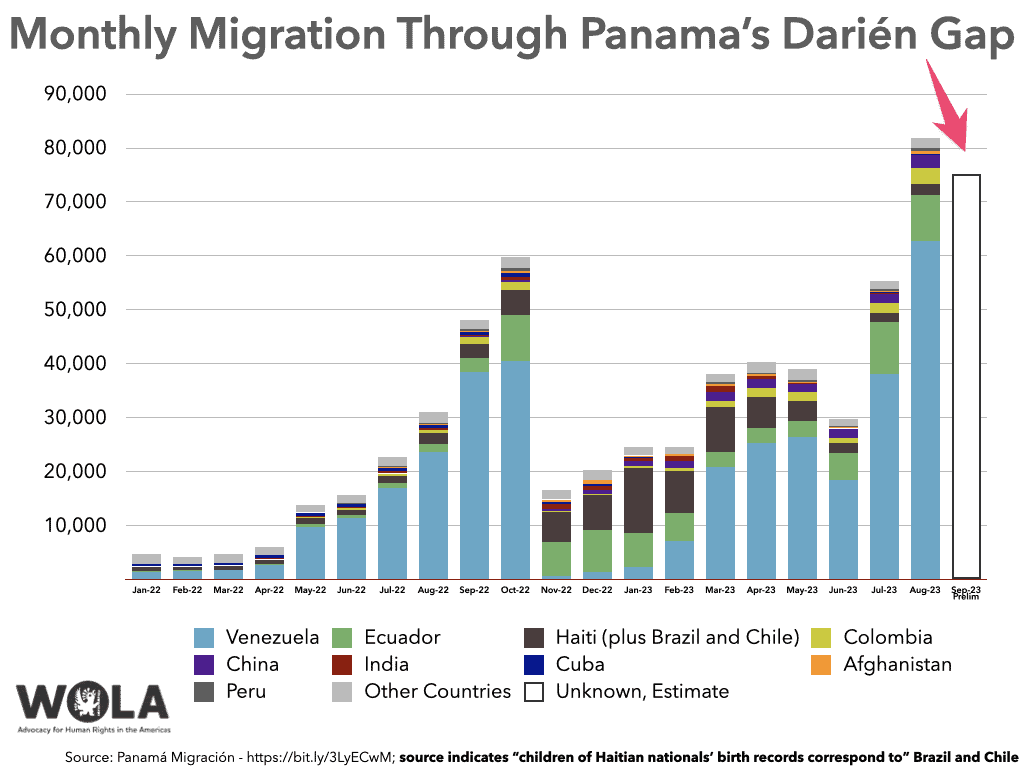With this series of weekly updates, WOLA seeks to cover the most important developments at the U.S.-Mexico border. See past weekly updates here.
Two important policy developments occurred as WOLA was drafting and editing this update on October 5. The Biden administration announced that it will waive environmental, public health, and cultural resource protection laws to expedite the construction of the border wall in south Texas. The State Department announced that it will resume direct deportations of Venezuelan migrants to their home country, an economically collapsed dictatorship that the U.S. government does not formally recognize.
Preliminary data indicates that migration increased at the U.S.-Mexico border in September for the third consecutive month. Fiscal 2023 was Border Patrol’s number-two year ever for migrant apprehensions, exceeded only by 2022. 50,000 of September’s Border Patrol apprehensions were reportedly of citizens of Venezuela, which would be a record for a nationality other than Mexico. High migration levels have brought tensions and human rights concerns in San Diego, El Paso, and elsewhere. Deaths of migrants in Border Patrol’s El Paso Sector more than doubled from 2022 to 2023.
U.S. and Mexican diplomats are meeting at the highest levels to discuss issues including migration. Mexico has signaled a willingness to deport more citizens of Ecuador, Venezuela and Colombia. The Biden administration is aiming to launch a pilot project to help Panama deport more migrants from the Darién Gap region.
About 6,000 people are crossing Mexico’s southern border every day, and the country is on track to exceed 150,000 asylum applications this year. Mexico continues to halt some trains and bus migrants into the interior, while accidents and attacks are claiming many lives along the migration route.
It appears that 75,268 migrants crossed the Darién Gap in September, the second largest-ever monthly total. A UN survey revealed that the average journey through this treacherous region lasts four days.
Two important policy developments occurred as WOLA was drafting and editing this update on October 5.
The Biden administration announced on October 5 that it will waive environmental, public health, and cultural resource protection laws to expedite the construction of the border wall in south Texas. This is the first time the Biden administration will use the 2005 REAL ID Act waiver authority, which bypasses 26 laws protecting clean air, water, public lands, endangered wildlife, and Indigenous grave sites. The plan has drawn criticism from conservation advocates who warned in a joint statement of potential harm to endangered species and the destruction of habitats in the Rio Grande Valley. Appropriations laws passed during the Trump presidency require that the money be used for wall-building; the administration interpreted that to mean it was also required to waive the 26 laws.
The Department of Homeland Security’s (DHS) Federal Register entry found “an acute and immediate need” to build walls “to prevent unlawful entries into the United States in the project areas,” a departure from the Biden administration’s oft-repeated view about the inefficacy of walls. Asked about it by reporters, Biden did not echo this: he said that appropriations required the new construction and that the border wall is not effective. Late in the day on the 5th, DHS Secretary Alejandro Mayorkas put out a statement accusing the media of taking the “acute and immediate need” language out of context.
Later on the 5th, the State Department announced that it will resume direct deportations of Venezuelan migrants to their home country, an economically collapsed dictatorship that the U.S. government does not formally recognize. In Venezuela, the government of Nicolás Maduro affirmed that it signed an accord to accept deportation flights.
The deportations announcement comes 15 days after a DHS Federal Register notice about the expansion of Temporary Protected Status for many Venezuelans in the United States, which found that “Venezuela continues to face a severe humanitarian emergency due to a political and economic crisis, as well as human rights violations and abuses and high levels of crime and violence, that impacts access to food, medicine, healthcare, water, electricity, and fuel, and has led to high levels of poverty.”
In April 2023, the U.S. government resumed deportation flights to Cuba. According to the latest monthly deportation-flight tracking report by Witness at the Border, one flight to Havana has run every month since then. It is not yet clear whether the tempo of flights to Caracas would be faster.
CBS News, citing internal Department of Homeland Security (DHS) data, reported on October 1 that Border Patrol apprehended “approximately 210,000” people at the U.S.-Mexico border in September.
U.S. Customs and Border Protection (CBP) probably won’t publish official data until the second half of October, so we don’t know the main nations of origin yet, or how many are adults, children, or families with children. But 210,000 migrant apprehensions would mean that migration increased at the border for the third consecutive month.
Border Patrol had reported apprehending 99,543 migrants in June 2023, the first month after the Title 42 pandemic expulsions policy ended. That was the fewest since February 2021. Migration recovered quickly, rising to 132,648 in July, 181,059 in August, and now apparently 210,000 in September, which would be the fourth-largest monthly total during the Biden administration.
 Data table without the September estimate
Data table without the September estimate
September is the last month of the U.S. government’s fiscal year. If Border Patrol apprehended 210,000 migrants in September, that would mean the agency apprehended about 2.04 million people during fiscal 2023. That would be the second-most ever, exceeded only by 2.21 million in 2022.
On October 4 CBS News reported new information about Venezuelan migration at the U.S.-Mexico border in September, also from preliminary DHS data. About 50,000 Venezuelan citizens last month crossed the border between ports of entry, ending up in Border Patrol custody. “On some days, as many as 3,000 migrants from Venezuela crossed into the U.S. illegally in 24 hours, the internal DHS figures show.”
50,000 Venezuelan citizens is almost certainly the greatest-ever number of migrants in a single month at the U.S.-Mexico border from any country other than Mexico. For non-Mexican migrants, the only monthly totals that come close are 45,201 citizens of Guatemala in May 2019, and 45,297 citizens of Honduras in July 2021.
 Data table without the September estimate
Data table without the September estimate
Large-scale U.S.-bound movement of Venezuelan citizens continues through the Darién Gap, Central America, and Mexico. If arrivals remain at September’s pace, calls to address the political and economic crisis causing so much migration may make Venezuela one of the Biden administration’s top foreign policy priorities.
Migration levels remained high in the past week. U.S.-Mexico border apprehensions totaled 9,000 on September 30, the New York Times reported. Axios stated on September 29 that “the daily numbers have neared 11,000 in recent days.”
In San Diego, where short-term shelters are full, groups like Al Otro Lado are asking for “volunteers fluent in Russian, French, Kreyol, Portuguese, Dari/Pashto, Amharic, Arabic, Hindi, Mandarin, Somali, Turkish, or Vietnamese to provide on-call translation services to the 100s of refugees from all over the world being released from CBP custody.”
At the westernmost end of the border, where the U.S. government is replacing the segment of border wall that leads down the beach and into the Pacific Ocean, about 80 to 100 people per day are attempting to cross into the United States by passing through or over the temporary fencing in place while rebuilding proceeds, the Mexican government’s National Immigration Institute (INM) told Border Report. Mexico has deployed National Guard troops to the site to deter would-be border crossers.
East of San Diego, Border Patrol continues to make large numbers of migrants wait out in the open near the California border town of Jacumba Springs, where difficult terrain has left gaps in the border wall. “Each day, anywhere from 150 to 800 migrants are trapped in this harsh desert environment, struggling to survive while Border Patrol fails to provide adequate food, water, hygiene products, or basic medical care,” Al Otro Lado tweeted.
On October 3 in Ciudad Juárez, across the border from El Paso, several hundred—perhaps more than a thousand—mostly Venezuelan migrants arrived aboard a freight train that had begun its route in Mexico state, just to the north of Mexico City. The group headed to the borderline and, wary of INM agents and police accompanying them, crossed the shallow Rio Grande early on October 4.
Now, a sort of encampment exists near “Gate 36” in the border wall. The Mexican daily Reforma described some migrants grouped along the wall, waiting to be processed by Border Patrol with almost no access to food or water. Another group waits on U.S. soil by the riverbank, separated from the Gate 36 group by coils of razor wire laid down by Texas state police and national guardsmen. This group has been filling bottles with polluted Rio Grande water and tossing them to the thirsty group by the border wall.
The Texas state government’s controversial “Operation Lone Star” continues to rely heavily on dozens of miles of razor-sharp concertina wire strung along the river to make it difficult for asylum seekers to reach U.S. soil after crossing. Breitbart, citing a CBP source, reported that two Texas National Guard soldiers in Eagle Pass were relieved of their duties as punishment for cutting the wire “to give access to migrants with small children who had been standing in the hot sun for hours.”
Several days earlier in El Paso, Reuters reported, the following scene involving Texas state personnel was caught on video:
a man crawled beneath coils of barbed wire as a young boy followed behind crying, “Papa, Papa.”
According to four videos of the incident seen by Reuters, an armed man in Texas National Guard uniform then stepped in the man’s path, and yelled, “I have no mercy, animals. Why did you send a baby? Why did you send a boy?”
Border Patrol data obtained by the El Paso Times record 148 deaths of migrants in the agency’s El Paso sector, which includes the border in the westernmost part of Texas and all of New Mexico. That is a record by far: more than double the 71 deaths the agency recorded in 2022, and more than 10 times the average of 13 recovered remains in the 24 years between 1998 and 2021.

More than 100 of the deaths occurred between May and September, a summer of record triple-digit heat in El Paso. The deadliest zone is the New Mexico desert closest to El Paso’s western outskirts, around Sunland Park and Santa Teresa, New Mexico.
In Brownsville, Texas, across from Matamoros, Tamaulipas, thousands of asylum seekers have been turning themselves in at the site of an abandoned golf course. Throughout Border Patrol’s south Texas Rio Grande Valley sector, migrant apprehensions totaled 4,000 over the September 30-October 1 weekend.
Secretary of State Antony Blinken, Attorney General Merrick Garland, and Homeland Security Secretary Alejandro Mayorkas traveled to Mexico on October 4 for the latest round of a bilateral space known as the U.S.-Mexico High-Level Security Dialogue. They met with Mexican President Andrés Manuel López Obrador to discuss what the New York Times called “increasingly contentious” topics like drug trafficking and migration.
U.S. officials are pressing Mexican counterparts to deploy more security personnel to take down fentanyl labs and interdict the synthetic opioid’s mostly Chinese-made precursor chemicals. On migration, the Times added that “the Biden administration is hopeful that Mexico will step up enforcement near the country’s southern border with Guatemala to slow the pace of migrants approaching the U.S. border.” Discussions will also focus on opening a processing center in the country’s south, where migrants could apply for U.S. refugee status without having to travel to the border to request asylum.
The visit comes days after September 29 meetings at the State Department between Mexican Foreign Minister Alicia Bárcena and Blinken, Commerce Secretary Gina Raimondo, and U.S. Trade Representative Katherine Tai.
Following those meetings, Bárcena said that Mexican officials are “looking to carry out ‘assisted returns’ of migrants to Ecuador, Venezuela and Colombia, in addition to current deportation flights to the trio of Central American nations, Guatemala, Honduras and El Salvador,” Reuters and EFE reported. Mexico most often uses buses to deport Central American citizens by land.
Axios revealed on September 29 that the Biden administration is notifying Congress of plans to spend $10 million to help Panama carry out a similar program of aerial deportations of migrants who pass through the treacherous Darién Gap jungle region straddling Colombia and Panama. It is to be a six-month pilot effort, initially targeting single adult male migrants, and would send some back to Venezuela.
The program has apparently been in the works for months, but had been blocked by Sen. Bob Menendez (D-New Jersey), who has had to step down from his chairmanship of the Senate Foreign Relations Committee following a September indictment on corruption charges.
“Mexican officials said 6,000 people were crossing its southern border every day,” the New York Times reported, while President López Obrador said on October 2 that as many as 10,000 people per day are reaching the U.S. border.
The Mexican president’s comments appeared to blame much migration on U.S. sanctions aimed at Cuba and Venezuela. While sanctions may make those countries’ economic recoveries more difficult, they are one of a few factors to blame for their crises, such as authoritarianism, economic mismanagement, and corruption.
The Mexican government’s Refugee Aid Commission (COMAR) released data about applications during what is certain to be a record-breaking year for Mexico’s asylum system. The number of people requesting asylum in Mexico is on track to exceed 150,000 in 2023.
 Data table
Data table
In September, Mexico received 11,984 asylum requests, the second-lowest monthly total all year. So far this year, 33 percent came from citizens of Haiti, plus another 6 percent from Brazil and Chile who are almost entirely the children born in those countries to Haitian migrants there. Honduras followed with 27 percent, then Cuba (11 percent).
COMAR is struggling to keep up with applications, especially in Mexico’s southern border-zone city of Tapachula. Wilner Metelus, who heads Mexico’s non-governmental Citizen Committee in Defense of Naturalized and Afro-Mexicans, told a press conference of cases of people in Tapachula who have been waiting eight months “for a response to their request for refuge,” adding that the city’s Siglo XXI migrant detention center, reputed to be Latin America’s largest with a 1,200 capacity, has “overcrowding of around 3,500.”
The government of the border state of Chihuahua, which includes Ciudad Juárez, estimated that trade disruptions resulting from the rise in migrant arrivals cost the state’s economy more than $947 million between September 18 and October 2, Reuters reported.
Those disruptions include the cancellation of some scheduled cargo trains amid efforts to prevent migrants from traveling on the cars, a dangerous practice. Trains abruptly stopped in a few locations last week, stranding migrants in deserts of Chihuahua and Coahuila states, Reuters and Raichalí reported.
With large numbers of migrants crowded at migration offices and bus stations at sites in Chiapas and elsewhere in Mexico’s far south, the national government has increased busing of migrants to sites elsewhere in the country’s interior, especially Mexico City, in order to relieve pressure. Reuters reported from Juchitán, Oaxaca, a center of the busing operation through which 800 to 1,000 migrants are passing daily. Migrants must pay their own bus fare.
Ten Cuban migrants died when the freight truck in which they were riding crashed on a highway in Chiapas, several dozen miles from the Guatemala border, on October 1. The truck’s driver apparently was speeding, lost control of the vehicle, and fled the scene after the crash. The Associated Press noted that vehicle accidents killed migrants last week elsewhere in Chiapas and in Mexicali, while two Central American migrants died trying to board a train in Coahuila.
On September 29, two Mexican migrants were shot, and three wounded, by attackers near Tecate, east of Tijuana. It was the third attack on migrants in Tecate, with a combined death toll of 11 people, in approximately the past month, probably the result of criminal groups competing for control of migrant trafficking routes.
An investigation by four Reuters reporters found a link between migrants’ wait for CBP One appointments at border ports of entry, and an increase in attacks and extortion, some involving rape of migrant women, in Mexico’s organized crime-dominated northern border state of Tamaulipas. “The high risk of kidnapping and sexual assault in Reynosa and Matamoros is one of the factors pushing migrants to cross illegally,” four advocates told Reuters.
Interviewed by the Mexican daily Milenio, officials of the UN International Organization for Migration (IOM) pointed out that 15 percent of migrants detained in Mexico so far this year come from countries in Asia and Africa. Among Mexico’s reported migrant encounters between January and August, the top 25 nationalities include China (11th), India (12), Mauritania (14), Uzbekistan (16), Angola (17), Guinea (19), Kyrgyzstan (21), Ghana (22), Afghanistan (23), Cameroon (24), and Egypt (25).
Milenio also reported that the number of Chinese migrants transiting Mexico has tripled in the past two years, “generating an additional $1.494 billion this year for criminal groups.” The newspaper added, “Chinese migrants are considered VIP clients of Mexican cartels, paying up to three times more than the $15,000 paid by migrants from Honduras, Venezuela, Ecuador, or Mexico.” Migrants from China often enter the Americas via Ecuador, which does not require that they apply for a visa ahead of time.
Earlier this year, migrants from China had mostly been arriving at Border Patrol’s sectors in south Texas (Rio Grande Valley) and the Arizona-California border (Yuma, El Centro). Since July, their principal destination has shifted to San Diego. Victor Shih, a professor of political economy at the University of California San Diego, told the San Diego Union Tribune that while many “have a plausible story of being oppressed by the Chinese government,” he believes most are fleeing “economic slowdown and limited employment opportunities in China.”
CBS News, citing Panamanian officials, reported that 75,268 migrants in September crossed the Darién Gap region straddling Colombia and Panama. That is the second-largest monthly number of people crossing the Darién ever, after the record 81,946 recorded in August.
 Data table without the September estimate
Data table without the September estimate
The UN Refugee Agency’s latest “Mixed Movements Protection Monitoring” report for the Darién Gap includes results of a survey of migrants who completed the journey through the region. 43 percent reported traveling with their entire family, and only 22 percent “reported traveling alone or with unrelated companions.” 50 percent left their country of origin or residence less than four weeks ago, and 41 percent had applied for legal status in another country before arriving in Panama—largely an indicator of Venezuelans or Haitians who had sought to settle elsewhere in South America. The journey through the Darién averaged four days; four in ten “experienced mistreatment or abuse during the journey through the jungle.”
The Colombian government’s internal affairs body (Procuraduría) is investigating migrant smugglers’ use of Colombia’s Caribbean island of San Andrés, not far from Nicaragua, as a stop on a sea route to avoid the Darién Gap. Migrants apparently pay between $1,500 and $5,000 to travel this way. The route is not necessarily safer than the Darién: in 2022, at least 59 migrants went missing after the boats in which they were traveling were shipwrecked.
Agénce France Presse reported from Paso Canoas along the Costa Rica-Panama border, where a growing number of migrants, many of them families and many in poor health, are arriving after traveling through the Darién Gap. Those who cannot afford the $30 per person bus fare are stranded for days there at a muddy, primitive camp. Using support from UN agencies and funds freed up by a late-September emergency declaration, Costa Rica’s government is replacing the camp with a “Temporary Migrant Care Center” (Catem) offering medical care, meals, showers, and bathrooms.